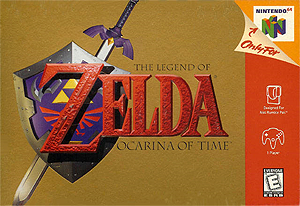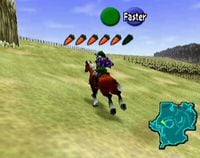The Legend of Zelda: Ocarina of Time
| The Legend of Zelda: Ocarina of Time | |
|---|---|
 
Box cover for the North American version of The Legend of Zelda: Ocarina of Time | |
| Developer(s) | Nintendo EAD |
| Publisher(s) | Nintendo |
| Designer(s) | Shigeru Miyamoto (producer/director) |
| Engine | Derivative of Super Mario 64 engine |
| Picture format | 4:3 Aspect ratio |
| Released | Nintendo 64 Nintendo GameCube iQue Virtual Console |
| Genre(s) | Action-adventure |
| Mode(s) | Single-player |
| Ratings | ESRB: E, E10+ (3D) ELSPA: 3+ OFLC: G8+ PEGI: 7+ (GameCube), 12+ (Wii, 3D) |
| Platform(s) | Nintendo 64, Nintendo GameCube, iQue, Virtual Console, Nintendo 3DS, Nintendo Switch Online Expansion Pass |
| Input methods | Gamepad |
| Article on Zelda Wiki | The Legend of Zelda: Ocarina of Time |
The Legend of Zelda: Ocarina of Time (ゼルダの伝説 時のオカリナ, The Legend of Zelda: Ocarina of Time), commonly abbreviated as OoT and often simply called Ocarina of Time, is the fifth mainline entry in The Legend of Zelda series. Originally released in 1998, it was the first The Legend of Zelda title to feature 3D graphics, and the first of two Zelda titles for the Nintendo 64, the other being its direct sequel, The Legend of Zelda: Majora's Mask. It is often considered to be the best game in the Zelda franchise, and is even considered by many to be the best game of all time. The game has since remade for Nintendo GameCube and Nintendo 3DS, the latter calling the remake The Legend of Zelda: Ocarina of Time 3D
In the Super Smash Bros. series[edit]
Fighters[edit]
Link's appearance in both Super Smash Bros. and Super Smash Bros. Melee is based on this game. The same applies to Zelda and Sheik in Melee, as well Ganondorf in Melee and Ultimate. Sheik and Ganondorf debuted in this game. Young Link is based on Link's younger version from this game.
Moves[edit]
Nayru's Love, Din's Fire, and Farore's Wind (which are Zelda's neutral special move, side special move, and up special move respectively) come from this game. In Ocarina of Time, these magic spells are used by Link, with Nayru's Love making the player temporarily invincible, Din's Fire being an area-hitting fire attack, and Farore's Wind allowing the player to warp back to a room in a dungeon. Transform, Zelda and Sheik's shared Down special move in Melee and Brawl references a cutscene in Ocarina of Time where Sheik reveals that she is Zelda. Fire Arrow (or Fire Bow in Melee), Young Link's Neutral Special as well as one of Toon Link's Custom moves in Smash 4 makes its debut in this game. Fire Arrows are often used to light torches from far away, as well as dealing extra damage to enemies. Ganondorf’s Forward aerial resembles a similar attack he uses in artwork for this game. Link's dash attack in Smash 4 and Ultimate, which references the Jump Slash, originates from this game.
Stages[edit]
Hyrule Castle in Super Smash Bros., Super Smash Bros. 4 and Super Smash Bros. Ultimate is based on the Ocarina of Time design, although it does incorporate elements from earlier games. It is the place where Zelda lives. Gerudo Valley also comes from this game, particularly the 3DS remake.
Items[edit]
The Bunny Hood and Deku Nut come from this game. One of the side missions in the game requires Young Link to sell various masks to the citizens of Hyrule. Young Link finds the Running Man in Hyrule Field and sells the Bunny Hood to him. Once Young Link sells the Bunny Hood, he is able to borrow it from the Happy Mask Salesman at anytime. Deku Nuts can be used to stun certain enemies in the game.
Enemies[edit]
ReDeads first appeared in this game and appear as enemies in Adventure Mode and Smash Run. Octoroks, Like Likes, Bubbles, Peahats, and Stalfos didn't debut in this game, but use their designs from this game in the single-player modes they appear in. (The exception being Octoroks in Smash Run, who use their Skyward Sword design).
In Ultimate, Ganon appears as a boss, reusing the model from his updated Final Smash. He can be found at the Sacred Land sub-dungeon in World of Light, and the battle itself takes place on a unique stage that resembles the ruined castle from the final boss of this game.
Trophies[edit]
Three trophies of Link, Zelda, Young Link and Ganondorf, all based on their Ocarina of Time incarnations, appear in Melee. The Bunny Hood, Lon Lon Milk, Master Sword (as it appears in Ocarina of Time), ReDead, Goron, and Ocarina of time also appear as trophies in Melee.
Bunny Hood and Deku Nuts appear as trophies in Brawl. Ocarina of Time is referenced in the trophy descriptions of Sheik and Ganondorf.
Bunny Hood, Bombchu, Deku Nuts, Skull Kid, ReDead appear in all versions of Smash 4. Adult Link (Ocarina of Time), Young Zelda (Ocarina of Time), Adult Zelda (Ocarina of Time), Ganondorf, Saria, Impa (as she appears in Ocarina of Time), Malon, Gorons, Zoras (as they appear in Ocarina of Time), Skulltula and Twinrova appear exclusively in Super Smash Bros. for Nintendo 3DS. Ocarina of Time is referenced in the trophy descriptions of Sheik, Sheik (Alt.), Ganondorf, Ganondorf (Alt.) and Cucco.
Stickers[edit]
Goron, Skulltula, Ocarina of Time, ReDead, Hookshot, Sheik, Deku Baba, Young Zelda, King Dodongo, Phantom Ganon, Ganondorf, Skull Kid, King Zora, and Lon Lon Milk appear as stickers. Octorok, Epona & Link, Zelda and Zora use artwork from this game.
Spirits[edit]
Young Link, Sheik, Ganondorf, Young Zelda, Zelda (Ocarina of Time), Impa (Ocarina of Time), Ruto, Koume & Kotake, Twinrova, ReDead, Skull Kid, Saria, Kaepora Gaebora, Malon, Epona, Goron, Happy Mask Salesman and Darunia appear as spirits. Moblin, Ganon and Zora use artwork from this game.
Music[edit]
"Saria's Song", "Ocarina of Time Medley", "Hyrule Field Theme", "Song of Storms", "Gerudo Valley (Brawl)", "Gerudo Valley (3DS)" and "Saria's Song / Middle Boss Battle" come from this game. "Ocarina of Time Medley" is a medley of several music pieces from this game. It starts as a remix of Zelda's Lullaby, then transitions into Sun's Song, a small extract of Minuet of Forest and Bolero of Fire, all remixed on an ocarina to be reminiscent of how Link would play these songs on the Ocarina of Time. A very small part is taken from the Boss introduction theme, remixed on a piano, before reverting back to the ocarina to remix the Windmill Hut, which is the basis for the Song of Storms, and Lon Lon Ranch, which is the basis for Epona's Song. These sections are classed as remixes of Windmill Hut and Lon Lon Ranch respectively, because Link never played the full versions of these songs within the Song of Storms and Epona's Song. After this, the arrangement switches to a full orchestra in order to remix the Song of Time and Saria's Song. The Saria's Song remix could be considered a remix of The Lost Woods, as under normal circumstances, Link would not play the full song on his ocarina, but if he plays the piece to Darunia, Saria's Song will be extended. After Saria's Song ends, the song will loop, reverting back to ocarina-based remixes. "Hyrule Field Theme" a remix of the theme that plays on Hyrule Field during the daytime. "Song of Storms" is for the most part a remix of The Windmill Hut theme, the inspiration behind the Song of Storms, but this arrangement also features an original interlude, the music that plays in cutscenes involving Ganondorf, and the Serenade of Water. "Gerudo Valley (Brawl)" is a direct port of the music that plays when Link explores Gerudo Valley and Gerudo's Fortress. "Gerudo Valley (3DS)" is a remix of the previously mentioned theme. "Saria's Song / Middle Boss Battle" is a medley of the similiarly named songs.
Masterpiece[edit]
This game appears as a Masterpiece in every version of Super Smash Bros. Brawl except the Korean version. It can be played for 300 seconds and has save files for beginning of Young Link and Adult Link sections. It must be unlocked by using Toon Link in 10 brawls.
Trivia[edit]
- Within the time limit, speedrunners have been able to beat Ocarina of Time (using glitches to either beat Ganon[1] or warp to the credits,[2] both of which were first done by Savestate).
References[edit]
| Masterpieces in Super Smash Bros. Brawl | |
|---|---|
| Starter games | Ice Climber · Kid Icarus · Kirby's Adventure · Star Fox 64 · Super Mario Bros. · Super Metroid · The Legend of Zelda |
| Japan-only games | EarthBound · Fire Emblem: Mystery of the Emblem |
| Unlockable games | Donkey Kong · F-Zero · Super Mario Bros. 2 · Super Mario World · The Legend of Zelda · The Legend of Zelda: Ocarina of Time |
